Shelter climbing roses for the winter - what experienced gardeners advise
Climbing roses need shelter for the winter more than hybrid tea, ground cover and park roses. Their main difference is the presence of flexible, non-lignified shoots. This is both a guarantee of the beauty of such plants, and the main source of problems: without a strong bark, they will not survive frost. It is no coincidence that this species is most popular in mild climates.
- General recommendations
- Shelter timing
- Preparing roses
- Top dressing
- Watering and loosening
- Pruning
- Treatment against diseases and pests
- Hilling
- The choice of covering material
- Film
- Spunbond
- Sackcloth
- Cardboard
- Roofing material
- Spruce or pine branches
- Winter protection methods
- Frameless shelters
- Frame structures
- When the shelter is being removed
- Brief instruction
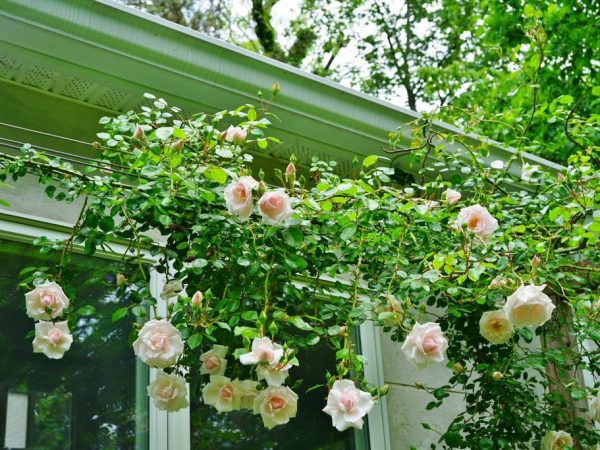
Shelter climbing roses for the winter - what experienced gardeners advise
General recommendations
To grow climbing roses in harsh conditions, you need:
- choose zoned varieties;
- provide special autumn care;
- organize a winter shelter that ensures dryness and air supply to the branches (it will take on part of the function of a dense bark).
Breeders have bred modern varieties that can withstand cold weather without significant losses, but it is necessary to know the characteristics of liana plants in order for the shelter to benefit them.
The main operation for ordinary roses, which protects the bush from freezing, is the autumn radical pruning of shoots. But for climbing, it is contraindicated. They form buds on the branches of the last year and on the lignified branches of the current one. Low-cut stems will not bloom next season.
A competent shelter for the winter will provide luxurious flowering and save:
- from freezing;
- frost breaker;
- untimely activation of life processes.
Timing hideouts
Climbing roses tolerate temperatures as low as -10 ° C. Moreover, with such a slight cold, their stems are hardened and woody faster, which means they will enter the winter prepared.
But too early shelter can ruin the flowers. As well as the belated removal of the protective structure in the spring.
The main cause of death is damping. His roses are more afraid than frost.
The optimal time for creating insulation is the onset of a constant minus temperature during the day at 5-7 ° C:
- in the suburbs - late October-mid-November;
- in the Urals - in the first half of October;
- in North and Central Siberia - end of September;
- in the south of Siberia - early October;
- in the Leningrad region and in the North-West - the very end of October.
Training roses
Climbing varieties "incorrectly" react to the autumn pruning of young branches - they can expel new shoots from the cut.
Even small changes in temperature and humidity provoke the awakening of the buds and the activation of life processes in the stems.
These features are explained by the fact that the plant cannot independently go into the period of biological dormancy. With a slight frost, activity only slows down, it is able to resume from minor reasons.
Shelter of climbing roses for the winter is carried out in 2 stages:
- Preparation, which is aimed at transferring the bush to the deepest possible autumn slowdown in life and increasing the maximum area of lignification.
- Placement in a covering structure.
Top dressing
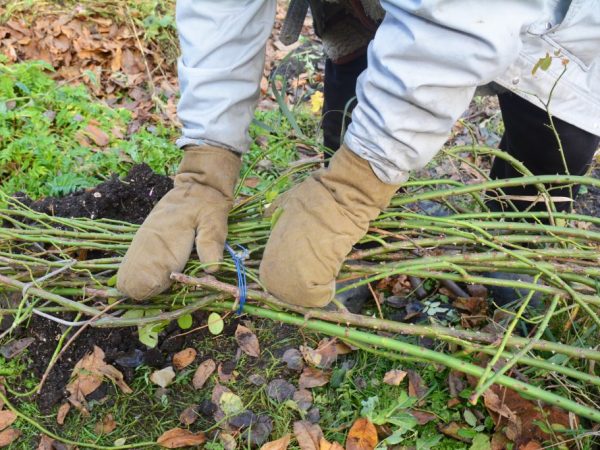
Plants will stay healthy when properly prepared for winter.
Starting from the first days of August, roses are transferred to top dressing with potassium-phosphorus fertilizers with additives that contribute to the development of the root system and the ripening of the shoots of the current year.
Since that time, nitrogen for climbing bushes has been strictly prohibited.
Food composition for 10 liters of water:
- 1 superphosphate matchbox;
- 0.5 matchbox of potassium sulfate;
- 2.5 g of boric acid.
The solution is distributed over 4-5 sq. m area.
After a month, feeding is repeated, replacing potassium sulfate with potassium monosulfate or potassium magnesium (20 g). Extraction from stove (wood) ash also helps: 1 glass per bucket of water.
It is easier to use autumn fertilizer for flowering plants. Then you definitely can't go wrong with the dosage.
It is very good to carry out foliar feeding of lashes in preparation for winter. To do this, you need to dilute the above composition 3-4 times and spray the vines. During flowering, spraying on the leaf is not welcome: the decorativeness of flowers may suffer.
Watering and loosening
Watering is stopped since August. Restriction in liquid promotes drying of wood, which means that it will not crack during frost.
At the end of the last summer month, the loosening and digging of the near-trunk circle are stopped so as not to cause the growth of root points of renewal.
Pruning
The climbing rose reacts to pruning flowers with the formation of new peduncles. Therefore, in the fall, in preparation for the winter period, they are not cut off on the liana. Such an operation at above-zero temperatures can provoke the awakening of the flower bud below the cut and the growth of young shoots.
On the contrary, the formation of seed bolls (seed pods) leads to lignification of the branch, which will have a beneficial effect in winter.
If the rose is actively blooming, you can interrupt this process by bending the peduncle near the bud.
Be sure to crop:
- Young stems from the center of the bush, which began to grow in late August-September. They have not yet gained strength for flowering, and in winter they will still freeze out.
- Branches and shoots growing inward, basal shoots thickening it. They are cut at the root.
- Leaves at the bottom of the vine, leaving petioles that cover the buds of growth.
- Sick and damaged leaves.
- Compound fruits.
Note! Leaf blades are not cut off, so as not to disturb the renewal zone.
With the onset of stable frosts (3-4 ° C), immediately before the shelter, they begin to cut off the faded shoots to the lignified part. It is difficult for beginners to define this boundary.
There are several signs:
- By touch, you can understand which part of the branch will overwinter or freeze: you need to touch it at sub-zero air temperatures. A cold shoot will die in winter, a warm one will survive.
- It is believed that the stems will survive the winter, from which thorns are easily pinched off.
Cut the bush in dry weather. Large sections are sealed with garden varnish or sprinkled with wood ash.
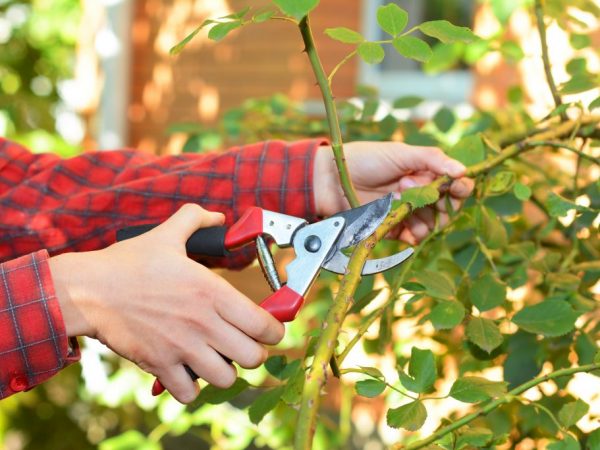
Pruning preferably in dry weather
2-3 days after pruning the branches, remove the remaining leaves if possible. With the onset of frost, they crumble if the branches are vigorously shaken.
The opinions of gardeners on the complete removal of leaf blades were divided. Some believe that some of the healthy ones should be left if the rose is covered with a non-woven translucent material. Under it, the leaves continue to participate in photosynthesis even with a slight minus outside.
Treatment against diseases and pests
After pruning, the vines need to be treated with Bordeaux liquid (2%). This is especially important for those shoots from which the leaves are not completely cut off. The solution is prepared in accordance with the instructions.
The use of biological products for autumn processing is impractical: they begin to work only at positive temperatures.
All plant residues are removed from under the bush and the soil is treated with fungicides.
Before the shelter, shoots and the ground are abundantly sprinkled with ash, which dries the soil well and prevents the spread of powdery mildew.
Hilling
After all the treatments, the vines are freed from the fasteners so that the branches move to a horizontal position under their own weight.
This is important if the frost is resistant: the shoots become brittle and their forced strong bending will lead to breakages.
The hilling of the bush is carried out with dry earth mixed with sand. Not suitable for these purposes:
- manure, compost;
- sawdust;
- peat,
- leaves.
These materials absorb and retain moisture well, which will lead to decay and mating of the root collar.
The height of the hilling of the base is 20-25 cm. It is optimal to put the spruce branches on top in one layer.
After 5-7 days, the plant is completely covered. To do this, put coniferous branches, boards, roofing material, plywood on the soil - any material that does not absorb moisture well.
Attention! It is impossible to lay the branches of a rose on bare ground. The bush is pressed to the ground with special pins or arcs.
The choice of covering material
The purpose of protective structures is to protect from frost in winter, moisture and heat during thaw. Therefore, the covering material must be air-permeable!
Film
To protect against high humidity, gardeners use plastic wrap.
Its advantages:
- waterproof;
- transmits sunlight;
- cheap.
The main disadvantage is that it does not allow the plant to breathe. When completely covered with such material, condensation will not evaporate. There is a high risk of podoprevanie with temperature fluctuations.
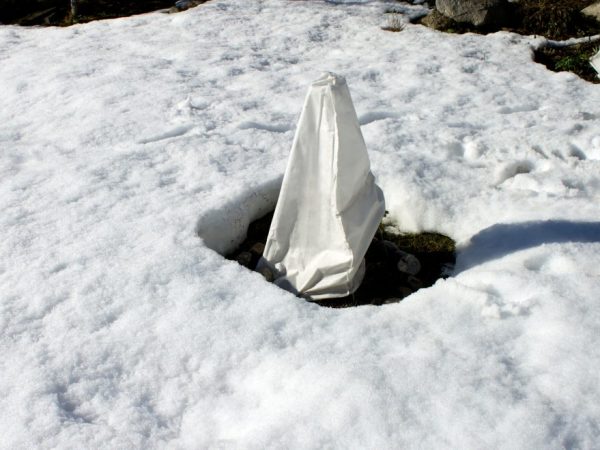
The film is not suitable for full cover
To avoid negative consequences, the film is used as follows:
- only in frame structures;
- laid on top of the "breathable" material;
- placed on top of the structure, leaving the ends and air vents free near the ground.
"Umbrella" made of film is well suited for drying shoots before full cover. To do this, stretch polyethylene onto the frame without closing the ends. Thus, the main condition for safe wintering is achieved - the plants must go dry in winter.
Spunbond
Ideal Shelter Material:
- Keeps you warm.
- Breathable.
- Prevents condensation formation.
- Transmits light.
- Shoots under such a shelter are capable of ripening if a light frost lasts for a long time to -8 C.
- When placed with the waxed side up, prevents moisture from entering.
- Does not absorb water.
- Dries quickly.
Spunbond is used with a density of 50-60 g / m² - in one layer or 30 g / m² - in 2 additions.
When choosing a material, you need to give preference to white - this way there will be less chance of spring sunburn. The same effect is achieved when using other non-woven shelters: lutrasila, agrila.
Sackcloth
This material is traditional for shelter construction. It's cheap and affordable. Its multiple use is possible.
However, burlap is not without its drawbacks:
- fabric for modern bags is woven with the addition of synthetic threads, which does not promote air exchange and leads to damping;
- this material allows moisture to pass through, which is critical for a rose;
- absorbs water. In frost, an ice crust forms on the wet surface, which will also not please the covered plant;
- pathogenic microflora may remain on reused bags.
You can use this covering material, but you must first disinfect it by soaking it in a pink solution of potassium permanganate for 30-40 minutes. You need to stretch the film on top, leaving air vents in the polyethylene layer.
Cardboard
The material at hand, its only advantage is budget. However, it gets wet quickly and dries for a long time. Craftsmen use cardboard boxes, covering them with polyethylene on top and placing them on bricks to isolate them from soil moisture.
The survival rate under such a shelter is small and depends entirely on the weather conditions.
Roofing material
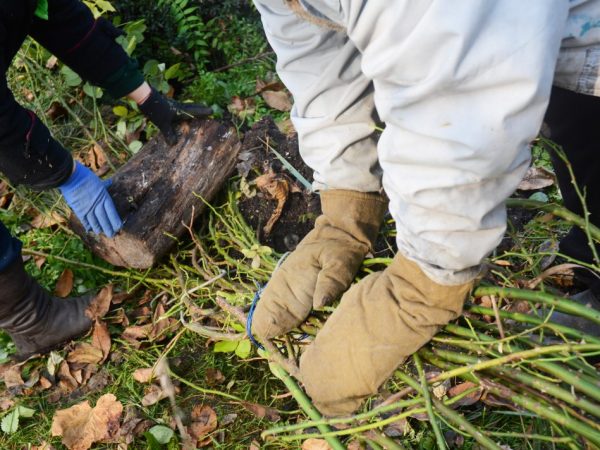
The method of shelter depends on the climate of the region
They are used in frame protective structures. Roofing material can withstand a layer of snow up to 1 m thick. Moisture-proof. To exclude mating, it is recommended to leave the air vents.
Unlike polyethylene, the material is not destroyed by sunlight, it can be used many times.
Spruce or pine branches
The most environmentally friendly covering material.
Its advantages:
- Protects from severe frosts.
- Prevents ice crust formation.
- Provides ventilation.
- Does not give in to decay.
- Provides sun protection.
- Prevents the development of pathogenic microorganisms.
Among the disadvantages - not always available, does not retain moisture. The most optimal combination is with spunbond.
The ways winter protection
Frameless shelters
If there is little or no snow at all, then it is enough to cover the rose lashes with covering material.
For the southern regions with mild winters, winding vines are not removed from the supports. The base of the bush is piled high (up to 30 cm), the branches are covered with spunbond and tied with ropes.
Where the snow cover is insignificant, shoots are laid on a layer of spruce branches, plywood, roofing material. The top is also covered with coniferous paws and a covering material is placed on top.
Frame structures
If there is a lot of snow, then a simple frameless shelter will not work - a snowdrift will press the covering material to the ground, the plant will not have enough air. To avoid this, a rigid structure is erected over the laid branches.
Basic requirements for the frame:
- It should provide a free space above the stems of at least 10-15 cm.
- Maintain the maximum snow depth observed in the area.
- Do not squeeze under the snow (have stiffeners at a short distance from each other).
Frames are constructed from wooden panels or planks, plywood sheets, rods, polypropylene pipes. The simplest design is of boxes covered with spunbond top.
When are filming shelter
It is important to build a protection for a climbing rose in time for the winter and also to remove it in time - a delay will lead to the plant damping out under the spring sun, and under an opaque cover the flower will also suffer from a lack of light.
It is necessary to open the bush gradually so that sunburn does not damage the whip.
In the Moscow region and in the middle zone of the Russian Federation, they do this in March, when the sun warms up during the day: they release the ends at the shelter or form air vents.
When the ground thaws and the average daily temperature is at least 4-5 °, all protection is removed.
Brief instruction
How to cover climbing roses for the winter:
- Preparations begin from the end of August: they stop watering, loosening, applying nitrogen fertilizers and organic matter.
- Until persistent cold weather is fed at least 2 times with phosphorus-potassium mixtures.
- Flowers and stems are not cut before the onset of constant frost.
- At an average daily minus air temperature of 5-6 C, leaves, shoots, and seedlings are removed.
- They are treated with 2% Bordeaux liquid.
- They sprinkle the bush with dry earth to a height of 25-30 cm.
- They are untied from the support and the branches are allowed to fall under their own weight.
- Shoots are laid on a layer of plywood, roofing material, spruce branches. Secure with brackets or arcs.
- They construct a frameless (with a snowless or little snowy winter) or frame shelter.
- The top is covered with a covering or improvised material that is waterproof, but allows the plant to breathe.
Growing climbing roses in Russia is not easy. But beauty requires sacrifice. Beaten up, but you can't say it more correctly. If you want your heart to sink in delight in front of a waterfall of fragrant flowers - work hard! A detailed and time-tested instruction is in front of you.

